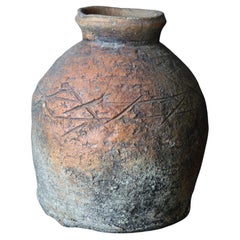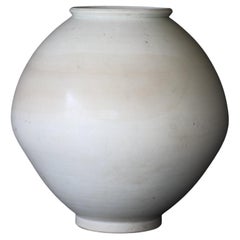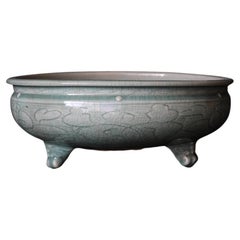
Established in 20121stDibs seller since 2022
Featured Pieces
Antique Shigaraki Jar "Uzukumaru"/Japanese Vase/14th-16th Century/Wabi-Sabi
Located in Kyoto-shi, Kyoto
During the Muromachi Period (1392–1573), the concept of wabi-sabi was formed from the tea ceremony culture.
Shigaraki ware was greatly influenced by the aesthetic sense of tea mas...
Category
Antique 15th Century and Earlier Japanese Antiquities
Materials
Ceramic
Moon Jar 'Dalhanari' - Lot2 / 17th Century / Korean Antiques / Joseon Dynasty
Located in Kyoto-shi, Kyoto
This is a white porcelain jar from the mid-Joseon period, also known as a "Talhunari" or "moon jar". During the Joseon Dynasty, which was strongly influenced by Confucianism, the purity of white porcelain was particularly prized in its artistic expression due to its Confucian sensitivity. The defining characteristic of white porcelain during this period was its pure white color, but there were many subtle variations in the white hues, with some being classified as milky white, snowy white, ashen white, and bluish white.
The term "Talhunari" means "moon jar" in Korean, and it refers to the large, round shape of the jar, resembling a full moon. It was named by Kim Whanki, a representative abstract painter of Korea. The soft, curving lines and sturdy body that seems to embrace the full moon give the jar both power and tranquility. This type of jar was produced in large quantities during the 17th century.
The white of the moon jar is not the pure white of early Joseon porcelain...
Category
Antique 17th Century Korean Antiquities
Materials
Ceramic, Porcelain
Moon Jar 'Dalhanari', Lot3 / 17th Century / Korean Antiques / Joseon Dynasty
Located in Kyoto-shi, Kyoto
This is a white porcelain jar from the mid-Joseon period, also known as a "Talhunari" or "moon jar". During the Joseon Dynasty, which was strongly influenced by Confucianism, the purity of white porcelain was particularly prized in its artistic expression due to its Confucian sensitivity. The defining characteristic of white porcelain during this period was its pure white color, but there were many subtle variations in the white hues, with some being classified as milky white, snowy white, ashen white, and bluish white.
The term "Talhunari" means "moon jar" in Korean, and it refers to the large, round shape of the jar, resembling a full moon. It was named by Kim Whanki, a representative abstract painter of Korea. The soft, curving lines and sturdy body that seems to embrace the full moon give the jar both power and tranquility. This type of jar was produced in large quantities during the 17th century.
The white of the moon jar is not the pure white of early Joseon porcelain...
Category
Antique 17th Century Korean Ceramics
Materials
Ceramic, Porcelain
Celadon Incense Burner with Peony Arabesque Design/Chinese Antique/14th-17th C
Located in Kyoto-shi, Kyoto
This is a Celadon three-legged incense burner with peony arabesque design.
Since the 14th century, Dwarf sedge was planted in this pot to decorate the tea room, so in Japan it is ...
Category
Antique 15th Century and Earlier Antiquities
Materials
Ceramic
White Porcelain Moon Jar, Joseon Dynasty / 1392-1897
Located in Kyoto-shi, Kyoto
This is a white porcelain jar from the mid-Joseon period, also known as a "Talhunari" or "moon jar". During the Joseon Dynasty, which was strongly influenced by Confucianism, the purity of white porcelain was particularly prized in its artistic expression due to its Confucian sensitivity. The defining characteristic of white porcelain during this period was its pure white color, but there were many subtle variations in the white hues, with some being classified as milky white, snowy white, ashen white, and bluish white.
The term "Talhunari" means "moon jar" in Korean, and it refers to the large, round shape of the jar, resembling a full moon. It was named by Kim Whanki, a representative abstract painter of Korea. The soft, curving lines and sturdy body that seems to embrace the full moon give the jar both power and tranquility. This type of jar was produced in large quantities during the 17th century.
The white of the moon jar is not the pure white of early Joseon porcelain...
Category
Antique 18th Century Korean Ceramics
Materials
Ceramic, Porcelain
Sue Ware Long Neck Jar / Japanese Antique / Asuka Period / 592-710 CE
Located in Kyoto-shi, Kyoto
Among Japanese Sue ware, the long-necked jar is a relatively new vessel that appeared around the 7th century. A typical long-necked jar with a delicately shaped bottom and a small bo...
Category
Antique 15th Century and Earlier Japanese Antiquities
Materials
Ceramic
Moon Jar / Korean Antique vase / Joseon Dynasty / 18th Century
Located in Kyoto-shi, Kyoto
It's a wonderful moon jar. It is a rare size that is suitable for the alcove of a Japanese tea room. It is shaped at once without connecting the uppe...
Category
Antique 18th Century Korean Antiquities
Materials
Ceramic
Sue Ware /Antique Japanese vase/4th-8th century/Wabi-sabi
Located in Kyoto-shi, Kyoto
This cup is an example of the type of stoneware known as Sue ware, produced from the middle of the fifth until the fourteenth century in Japan.
This produc...
Category
Antique 15th Century and Earlier Japanese Antiquities
Materials
Pottery
Vermillion Lacquer Rinka Tray/Chinese Antique/14th-17th century/Tea ware
Located in Kyoto-shi, Kyoto
This product is a rare six-sided vermillion lacquer rinka (ring of flowers) tray. It was made in the late Yuan and early Ming dynasties. It has been ca...
Category
Antique 15th Century and Earlier Chinese Antiquities
Materials
Wood
Johoji Lacquerware Katakuchi Choshi/Japanese Antique/Wabi-Sabi/1336-1573CE
Located in Kyoto-shi, Kyoto
Muromachi period old Joboji lacquered Kataguchi Choshi. There are very few extant items from this era, and they are very rare items.
This item has weathered over time, and the coa...
Category
Antique 15th Century and Earlier Antiquities
Materials
Wood
Longquan Celadon Plate / Chinese Antique / Song to Yuan Dynasty / 13th Century
Located in Kyoto-shi, Kyoto
The Longquan kiln, situated in Longquan City of China's Zhejiang Province, thrived in the Song and Yuan eras. It is characterized by its beautiful green celadon ware, created by appl...
Category
Antique 15th Century and Earlier Chinese Ceramics
Materials
Ceramic, Celadon
Kundika Bottle Celadon with Incised Flower / 12th Century / Korean Antique
Located in Kyoto-shi, Kyoto
A "Johin" is a vase used to hold pure and clean water. According to the ancient Buddhist scripture "Lotus Sutra," it was originally one of the 18 tools that Buddhist monks were required to possess, but later came to be used as a vessel for offering clean water to the Buddha. During Korea's Goryeo period, it was also commonly used as a water storage container.
The vase is adorned with delicate floral patterns engraved with fine lines on its front and back. Among other Goryeo celadon...
Category
Antique 15th Century and Earlier Korean Ceramics
Materials
Ceramic, Celadon
More About &Antique Kyoto




